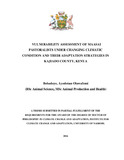| dc.description.abstract | Human adaptive responses to climate change occur at the local level, where climatic variability is experienced. Therefore understanding adaptive strategies at the local level is important in planning effective adaptation options in semi-arid environment. This study was therefore conducted to assess household vulnerability and adaptation strategies of Maasai pastoralists to climate change and variability in Kajiado County.
Transdisciplinary research approach was used to analyse the perception of Maasai pastoralist to climate change and variability; measure pastoralist vulnerability at the household level and evaluate their adaptation strategies to climate change and variability.
Primary data was collected using focus group discussions, household survey using questionnaire and key informant interviews. A total of 305 household interviews and 30 key informant interviews were conducted. Secondary rainfall and temperature data for 43 years (1970-2013) obtained from Kenya Meteorological Service was also analyzed. Data was analyzed using statistical package (R) software, and vulnerability maps showing the vulnerability level of communities in the study areas were produced using ArcGis 10.2 GIS software.
Results showed that Kajiado County has a bi-modal rainfall pattern with two distinct rainy seasons. Ngong (Kajiado north) had the highest average annual rainfall of 979.2mm, followed by Mashuuru (Kajiado central) 674.50mm, Isinya (Kajiado east) 612.6mm and least for Magadi (Kajiado west) 450.60mm. The results revealed a high level of spatial and temporal variability in rainfall trend in Kajiado County. The results showed that a rise in minimum temperature (1.410C), maximum temperature (0.470C) and average temperature (0.940C) occurred in the study area between 1970 and 2013. The study identified drought as the main climatic extreme event in the study area. The standardized precipitation index (SPI) results showed increase in drought occurrence in Kajiado County in the recent years, with six years (2000, 2003, 2004, 2007, 2008 and 2011) having negative SPI values from 2000-2011. The year 2000 was the driest year recorded, with an SPI value of -3.09. Results further showed that Maasai pastoralist
perceptions on temperature change and years of drought in the study area tally with evidence from Kenya meteorological service.
Vulnerability analysis showed that gender of household head, years of experience in the area, educational level, visit by extension agents, herd size, livestock diversity, credit access, land size and livestock mobility had significant influence on vulnerability of households in the study area. The study further revealed that Kaputiei North with high population density had the highest number of highly vulnerable households (33%), followed by Oloosirkon (19%), Kitengela and Imororo had (15%), while Kenyawa-Poka had the least percentage of highly vulnerable households (5%). The vulnerability map showed variation in the levels of vulnerability of households even within the same community. The study observed a direct correlation between vulnerability and availability of basic amenities in rural areas in Kajiado County. Maasai pastoralists are already taking measures such as rain harvesting, livestock diversity, early warning system and mobility to adapt to climate extremes. However, increase in drought occurrence in the last few years is reducing their resilience.
The study recommends collaboration among stakeholders and integration of various sources of knowledge in addressing climate change and variability among pastoralists in Kajiado County. Efficient early warning system using technologies such as mobile phones and community radio for climate information dissemination, rapid infrastructural development and efficient disaster management are no regret adaptations options that will reduce vulnerability of rural pastoral communities to climate change and variability. | en_US |



